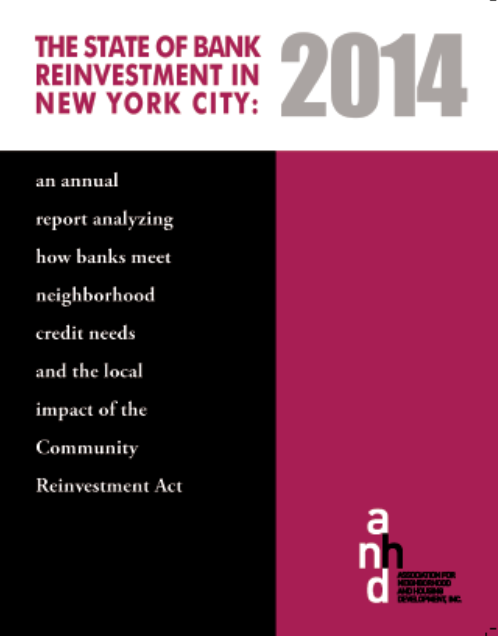ANHD Releases 2014 Bank Report
The Association for Neighborhood and Housing Development (ANHD) today released its annual report, State of Bank Reinvestment in NYC: 2014 analyzing the local impact of the Community Reinvestment Act (CRA), highlighting industry trends, and identifying and comparing how individual banks do or don’t meet our City’s credit and banking needs.
ANHD Releases State of Bank Reinvestment in New York City: 2014 Report
Click here to download the report
Click here to download Bank Report data chart
Click here to download Bank Report Chart of Reinvestment indexes
The Association for Neighborhood and Housing Development (ANHD) today (3/16/15) released its annual report, State of Bank Reinvestment in NYC: 2014 analyzing the local impact of the Community Reinvestment Act (CRA), highlighting industry trends, and identifying and comparing how individual banks do or don’t meet our City’s credit and banking needs.
The major findings of the Report (bulleted below) show that while locally held deposits in the 24 largest banks in New York City increased, the volume of dollars reinvested did not keep pace across all institutions. The Report provides concrete ways that NYC banks can better meet the credit and banking needs of NYC’s low- and moderate-income residents and neighborhoods.
ANHD has a deep appreciation of both the need for and the benefits of effective bank reinvestment and government policies that hold banks accountable to help meet the credit needs of our at-risk communities. Banks receive significant taxpayer-backed public benefits from the federal government. These benefits must come with the understanding that banks will provide their services equitably in the communities in which they operate.
New York City differs county by county and even block by block.
ANHD believes that reinvestment is most effective if the bank has a clear understanding of the local issues and needs of individual communities and how the bank’s reinvestment activity will address them.
- Local deposits were up 13% in 2012 and 8% in 2013, reaching $870 billion. However, in 2012 five banks increased deposits, yet decreased their reinvestment in NYC. In 2013, seven banks increased deposits but decreased reinvestment.
- The multifamily market remains strong, increasing in 2012 and 2013. The number and dollar of multifamily loans qualifying for community development increased in each year. While signs of physical and financial distress remain low, the rising rents and sales prices citywide, including in historically more affordable neighborhoods, are troubling and suggest that lower-income tenants everywhere will face even more pressure and probable harassment and displacement.
- Community development lending and investments increased in 2012 and again in 2013. The number of investments dipped in 2012, but rose again in 2013. Lending to nonprofits fluctuated, with the amount loaned down slightly in 2012 and up again much more in 2013, while the number of loans increased in 2012 and decreased again in 2013.
- CRA-eligible grant dollars decreased by nearly $3 million from 2011 to 2013, from $74 million to $71 million, with a larger decline to neighborhood based organizations. Among the banks that report grants to neighborhood based organizations, collectively about 30% of their grant dollars went to neighborhood based organizations; percentages vary by bank.
- With a few exceptions, the percentage of community development loans and investments under the economic development category is very small, highlighting the challenges with the category and the opportunity for activity to support quality jobs. 8 of 22 banks reported that none of their community development loans fell under the economic development category; only 7 reported 25% or more. 14 of 16 banks reported that less than 1% of their investments went for economic development.
- The number of branches remained relatively stable across the City, but the distribution remains inequitable, with core Manhattan inundated with branches, while lower-income neighborhoods in the Bronx, Brooklyn, and Queens still lack sufficient branches and ATMs. Some new accounts appear more accessible to lower income New Yorkers, but many remain out of reach.
- Loans to purchase 1-4 family homes increased by 9.6% in 2013, but only by 3.5% to lower income borrowers. In 2012, the number of loans overall declined by 2.4% overall and by nearly four times that (down 8.3%) to lower-income borrowers. Thousands of homeowners are still in, or at risk of, foreclosures, with the highest percentages in communities of color in Brooklyn, Queens, and the Bronx.
